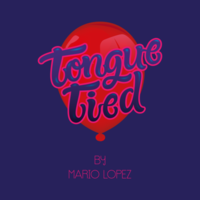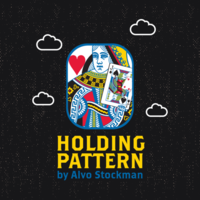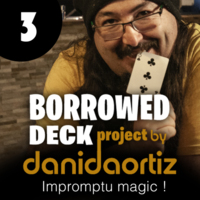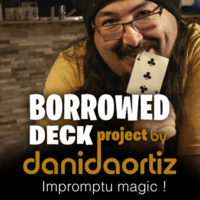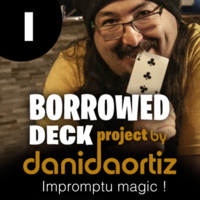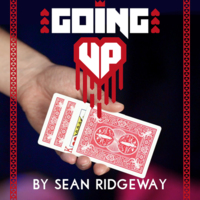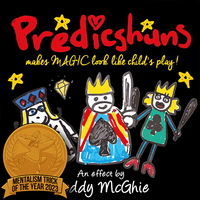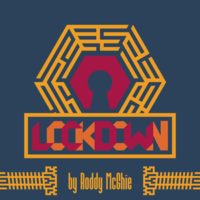Eric Jones LIVE (Penguin LIVE)
One of the most creative magicians on the planet came to Penguin for a magic-packed 2-hour live event. SUPPORT LIVE MAGIC. DOWNLOAD THE FULL LECTURE TODAY.
In stock: Download INSTANTLY.
“Eric’s magic is so smooth I wanted to watch it wearing only silk pajamas” - Aaron Delong
Questions about this product
1
votes
Eric Jones at the table live lecture
So I saw the trailer for Eric jones live lecture b...
Have a question about this product?
ASK HERE
ASK HERE
Featured Magic Tricks
Customer magic Acts that feature this trick
Customer Reviews (showing 1 - 10 of 10)
5 star 70%
4 star 20%
3 star 0%
2 star 10%
1 star 0%
4 star 20%
3 star 0%
2 star 10%
1 star 0%

 Magician Holds Back, Lecture Suffers
Report this review
Magician Holds Back, Lecture Suffers
Report this review
Verified buyer
Pro Privacy ON
(login to see reviewer names)
on August 31st, 2012
In this 2 hours, 33 mins lecture, Eric Jones performs a selection of mainly close-up material,
entirely with coins and cards. Roughly a third of the lecture focuses on gimmicks (magnetic flipper
coin with shell, as well as Erics own Twizted card gimmick). Another third of the lecture is
dedicated to moves that arent stand-alone routines. In my opinion, the lecture suffers a bit from
a lack of fully-routined, impromptu (or, no-extra-purchase-necessary) material. It doesnt help that
following his 3-Fly routine, Eric wanders away from the explanation and never returns. By finishing
the magic portion in under 2 hours, and focusing a considerable portion of the lecture on tricks
that rely on not-your-everyday-average gimmicks and including filler type material, this lecture
is underwhelming. Moderated by Dan Hauss.
Includes the following:
1. Fingertips pt. 1 (also referred to as Oxy-Clean Coin Routine) Standing 3-coin Production and Vanish. This is a pretty and magical sequence that relies on aforementioned gimmicked coin as well as a clever and simple hold-out that you can make for about . The gimmick is for use with short or rolled sleeves.
2. Bare-Handed 4-Coin Assembly this routine is performed on a close-up mat on the floor, with spectators looking down. It features a clever palming technique that is as clean-looking as it gets. The first 3 coin transfers are great, but the last one-to me-looked like he was doing exactly what he was doing.
3. Various tricks using the Twizted card gimmick This gimmick is available for purchase ().
4. Passless Pass This is a sleightless card control which relies on a spatial discrepancy. While Im sure this flies by many people, I also believe some people can see right through it. Further, as Eric says himself, it fools the spectator by confusing him. I dont agree that this is a good approach.
5. Oil and Water In this version, by Woody Aragon, the separation of mixed cards is self-working. Eric directs the spectators to push card packets together, themselves; colors then separate. This is a very clever idea. It should be noted, however, that a crimp is necessary, and the crimp is noticeable during the routine.
6. Marionette Coin Count In this false coin count, 3 coins effectively masquerade as four. The handling is very natural, and when positioned properly within a fully orbed trickas it is in Audio, available separatelycan make a marvel of a routine.
7. 3-Fly Performance only. Unfortunately, and contrary to what the first reviewerMagic Tia, from Italywrote, this is NOT explained. Eric opens by telling us this is a favorite and teaches it in every lecture. However, after the routine, he seems to get sidetracked by a request to cover a flourish featured in the routine. Eric goes on to teach a single coin roll (down the arm). Unfortunately, he does not return to 3-Fly.
8. Quarter/Penny Transpo (Scott Robinson) This is a simple, impromptu, in-the-hands transposition that doesnt need any extra coins. Cute, quick, not mind-blowing.
9. Card Translocation Trick This trick packs a wallop and seemed to stun the audience. Basically, a card is selectedbut not removed from the deckthrough a bit of procedure (think Overkill, by Paul Harris), then cleanly vanishes from the deck. Selection appears face-up, in packet spectator has held from the beginning (before the card was selected), which the performer has NEVER touched. This is a very strong moment, and will fool laypeople and magicians alike. However, for lay-audiences there are simpler methods for achieving the effect of a card or cards appearing in a card-packet held by the spectator. I would choose Paul Harris Las Vegas Leaper, which generates a similar response, but which can be done impromptu. Erics trick requires a (common) gaffed card and simple set-up.
10. Absolutely Brilliant Group Participation Card Trick Without a Name This trick (again, by Woody Aragon) was the gem of the lecture, for me. In fact, its probably the only thing here that I would use, but I would use the heck out of it. Each person in the room chooses 4 cards. The cards are fairly mixed, torn in half and mixed further. 1 piece is set aside. The remaining pieces are mixed, traded among friends, thrown in the air and lost until only 1 piece remains. The piece each person ends up with matches the piece put aside at the beginning. This could be gold for a stand-up performer, as you can involve every person in the room. Easy to apply a motivational theme, company concept, tarot, holiday, anything.
11. El Cambio Nada Card color change from Extension of Me/Theory 11. Pretty, done at high chest level, with performers face in the frame. Drawback is that you have to handle a single card with two hands.
12. Eclipse Card control. Very nice control inspired by Harry Loraynes Ultra-Move (which I dont know, so I cant compare.) With angle issues on both sides, this move is only meant for audiences head-on. This restriction aside, it is very clean-looking.
13. Elevator Cut Flourishy card cut, based on Karrel Foxs Butterfly Cut. Pretty. Not a false cut, although Eric shows how one can adjust for a false cut.
14. Enigma Change Copper/Silver coin transformation. In the hands, chest-level transformation for a head-on audience. Nice little move.
In conclusion, although Eric is a fine magician, he held back on this lecture. Considering the lack of fully formed, no-extra-purchase-necessary routines, I feel Audio should have been included and 3-Fly should have been taught. The strongest material was straight from Woody Aragon's new book, which is probably what I should have bought. On the other hand, if you own or are interested in the magnetic flipper coin and shell, and Erics Twizted card, then this lecture will be more valuable to you.
20 of 22 magicians found this helpful.
Includes the following:
1. Fingertips pt. 1 (also referred to as Oxy-Clean Coin Routine) Standing 3-coin Production and Vanish. This is a pretty and magical sequence that relies on aforementioned gimmicked coin as well as a clever and simple hold-out that you can make for about . The gimmick is for use with short or rolled sleeves.
2. Bare-Handed 4-Coin Assembly this routine is performed on a close-up mat on the floor, with spectators looking down. It features a clever palming technique that is as clean-looking as it gets. The first 3 coin transfers are great, but the last one-to me-looked like he was doing exactly what he was doing.
3. Various tricks using the Twizted card gimmick This gimmick is available for purchase ().
4. Passless Pass This is a sleightless card control which relies on a spatial discrepancy. While Im sure this flies by many people, I also believe some people can see right through it. Further, as Eric says himself, it fools the spectator by confusing him. I dont agree that this is a good approach.
5. Oil and Water In this version, by Woody Aragon, the separation of mixed cards is self-working. Eric directs the spectators to push card packets together, themselves; colors then separate. This is a very clever idea. It should be noted, however, that a crimp is necessary, and the crimp is noticeable during the routine.
6. Marionette Coin Count In this false coin count, 3 coins effectively masquerade as four. The handling is very natural, and when positioned properly within a fully orbed trickas it is in Audio, available separatelycan make a marvel of a routine.
7. 3-Fly Performance only. Unfortunately, and contrary to what the first reviewerMagic Tia, from Italywrote, this is NOT explained. Eric opens by telling us this is a favorite and teaches it in every lecture. However, after the routine, he seems to get sidetracked by a request to cover a flourish featured in the routine. Eric goes on to teach a single coin roll (down the arm). Unfortunately, he does not return to 3-Fly.
8. Quarter/Penny Transpo (Scott Robinson) This is a simple, impromptu, in-the-hands transposition that doesnt need any extra coins. Cute, quick, not mind-blowing.
9. Card Translocation Trick This trick packs a wallop and seemed to stun the audience. Basically, a card is selectedbut not removed from the deckthrough a bit of procedure (think Overkill, by Paul Harris), then cleanly vanishes from the deck. Selection appears face-up, in packet spectator has held from the beginning (before the card was selected), which the performer has NEVER touched. This is a very strong moment, and will fool laypeople and magicians alike. However, for lay-audiences there are simpler methods for achieving the effect of a card or cards appearing in a card-packet held by the spectator. I would choose Paul Harris Las Vegas Leaper, which generates a similar response, but which can be done impromptu. Erics trick requires a (common) gaffed card and simple set-up.
10. Absolutely Brilliant Group Participation Card Trick Without a Name This trick (again, by Woody Aragon) was the gem of the lecture, for me. In fact, its probably the only thing here that I would use, but I would use the heck out of it. Each person in the room chooses 4 cards. The cards are fairly mixed, torn in half and mixed further. 1 piece is set aside. The remaining pieces are mixed, traded among friends, thrown in the air and lost until only 1 piece remains. The piece each person ends up with matches the piece put aside at the beginning. This could be gold for a stand-up performer, as you can involve every person in the room. Easy to apply a motivational theme, company concept, tarot, holiday, anything.
11. El Cambio Nada Card color change from Extension of Me/Theory 11. Pretty, done at high chest level, with performers face in the frame. Drawback is that you have to handle a single card with two hands.
12. Eclipse Card control. Very nice control inspired by Harry Loraynes Ultra-Move (which I dont know, so I cant compare.) With angle issues on both sides, this move is only meant for audiences head-on. This restriction aside, it is very clean-looking.
13. Elevator Cut Flourishy card cut, based on Karrel Foxs Butterfly Cut. Pretty. Not a false cut, although Eric shows how one can adjust for a false cut.
14. Enigma Change Copper/Silver coin transformation. In the hands, chest-level transformation for a head-on audience. Nice little move.
In conclusion, although Eric is a fine magician, he held back on this lecture. Considering the lack of fully formed, no-extra-purchase-necessary routines, I feel Audio should have been included and 3-Fly should have been taught. The strongest material was straight from Woody Aragon's new book, which is probably what I should have bought. On the other hand, if you own or are interested in the magnetic flipper coin and shell, and Erics Twizted card, then this lecture will be more valuable to you.
Did this review help you?
Do you want to respond to this review?

 Eric's excellent lecture
Report this review
Eric's excellent lecture
Report this review
Pro Privacy ON
(login to see reviewer names)
on February 8th, 2013
Eric is very effective in his teaching. He provides a great environment to learn magic and has great
sleight of hand skills in that he explained the concepts very well and was able to explain in more
than one way.
1 of 1 magicians found this helpful.
Did this review help you?
Do you want to respond to this review?

 Eric jones lecture
Report this review
Eric jones lecture
Report this review
Verified buyer
Pro Privacy ON
(login to see reviewer names)
on October 6th, 2012
Fantastic. I have seen Eric lecture lives and of course you forget half of what he teaches what a
bargain this is. It is like seeing Eric over and over again while getting the lecture notes too.
Great concept. Not to mention the high quality of magic that Eric teaches. Real worker stuff. Keep
up the great work on this lecture series.
1 of 1 magicians found this helpful.
Did this review help you?
Do you want to respond to this review?

 Great tricks
Report this review
Great tricks
Report this review
Verified buyer
Pro Privacy ON
(login to see reviewer names)
on September 14th, 2012
If you want to spend on gimmicks it's 4 U ( shells & twisted by Eric ) some other card tricks (none
gimmicked come in pretty handy. I already do svca (3fly) & audio color Chang will work with other
tricks & face up or down changes. U spend between 60 up to 100 bucks on gimmicks pending on wut coin
gimmick U use. But 4 the effects its worth it if U perform. I agree there's too many gimmicks but it
will giv U extra ideas in creating some tricks or using them with tricks might already kno. Good
lecture Eric
1 of 1 magicians found this helpful.
Did this review help you?
Do you want to respond to this review?

 Eric Jones
Report this review
Eric Jones
Report this review
Verified buyer
Pro Privacy ON
(login to see reviewer names)
on September 8th, 2012
A little too much talking and not enough tricks.However the tricks that are on here are all killers.
I mean you will seriously fool people with these,including other magicians.
Most are easy to do--except for the audio move which needs a lot of practice to get the knack.
He uses material from his friend Woody Aragon and they was the best card tricks I have seen in a long time.
Overall,this has excellent material you will use--- but I would have liked more.
1 of 1 magicians found this helpful.
Most are easy to do--except for the audio move which needs a lot of practice to get the knack.
He uses material from his friend Woody Aragon and they was the best card tricks I have seen in a long time.
Overall,this has excellent material you will use--- but I would have liked more.
Did this review help you?
Do you want to respond to this review?

 two thumbs up
Report this review
two thumbs up
Report this review
Verified buyer
Pro Privacy ON
(login to see reviewer names)
on August 25th, 2012
Here you have Eric Jones at his best, lots of quality magic pressed down to about two hours. There's
something for everyone especially for all of us with passion for coins.
1 of 1 magicians found this helpful.
Did this review help you?
Do you want to respond to this review?
AWESOME LECTURE
ERIC HIS AN INCREDIBLE GUY,I HAVE SHARE A LOT OF INTERESTING MATERIAL,COIN AND CARD.
THERE IS A WONDERFUL IMPOSSIBLE THREE FLY COIN EXPLAINED, SOME VERY NICE COIN MOVES
AN INCREDIBLE "NO MOVES" OIL AND WATER,DO WITH THE SPECTATOR HAND.
A OTHER PAIR OF AUTOMATIC AND STRONG CARD TRICK,
A BEAUTIFUL COLOR CHANGE AND SO MUCH MORE......
THIS LECTURE MUST BUY
HIGHLY RECOMMENDED
WORTH THE MONEY
2 of 4 magicians found this helpful.
ERIC HIS AN INCREDIBLE GUY,I HAVE SHARE A LOT OF INTERESTING MATERIAL,COIN AND CARD.
THERE IS A WONDERFUL IMPOSSIBLE THREE FLY COIN EXPLAINED, SOME VERY NICE COIN MOVES
AN INCREDIBLE "NO MOVES" OIL AND WATER,DO WITH THE SPECTATOR HAND.
A OTHER PAIR OF AUTOMATIC AND STRONG CARD TRICK,
A BEAUTIFUL COLOR CHANGE AND SO MUCH MORE......
THIS LECTURE MUST BUY
HIGHLY RECOMMENDED
WORTH THE MONEY
Did this review help you?
Do you want to respond to this review?

 Eric Jones Lecture
Report this review
Eric Jones Lecture
Report this review
Verified buyer
Pro Privacy ON
(login to see reviewer names)
on April 2nd, 2015
I really liked the lecture it was excellent. Great teacher we booked him for a lecture here at Magic
Masters we had a great turnout for the lecture, big success, everyone loved the lecture. First time
to do your live lecture. I will do it again.
Did this review help you?
Do you want to respond to this review?

 Silky sleight of hands and fateful self workings
Report this review
Silky sleight of hands and fateful self workings
Report this review
Verified buyer
Pro Privacy ON
(login to see reviewer names)
on October 11th, 2012
Great, anyway great. You can learn his great sleight of hands, and self-working effects as well. The
self workings are from Woody Aragon, so both of sleight-of-hand effect and self-working effect are
totally in the bag.
Did this review help you?
Do you want to respond to this review?
this lecture was so good he even magically changed his penguin magic avatar from Eddie Murphy to
Eric Jones! Impressive!
0 of 1 magicians found this helpful.
Did this review help you?
Do you want to respond to this review?
OPEN BOX
$26.70 (10% OFF)
58
Bestsellers
See all bestsellers
COOL BOX
7% now claimed
1
0
:
3
8
:
4
7
remaining

Act Builder beta






